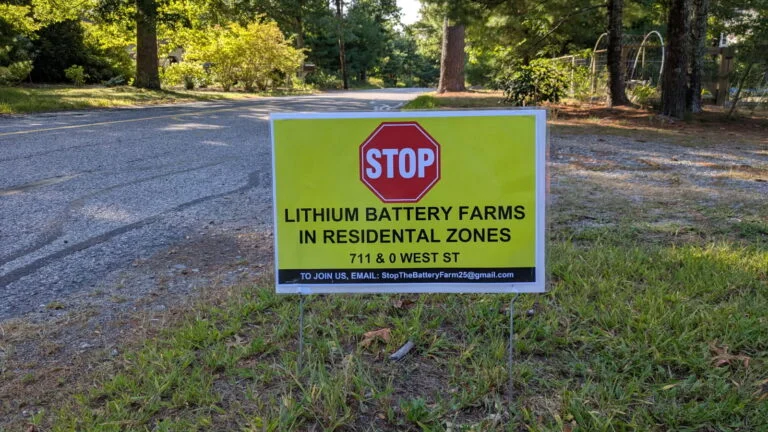
Bright yellow signs reading “Stop Lithium Battery Farms in Residential Zones” dot driveways, front lawns, and trees in the neighborhoods of suburban Duxbury on the South Shore.
According to residents, the signs began popping up a few weeks ago when word began to spread that developers, New Leaf Energy, were moving forward in their plans to construct a 5-megawatt battery storage facility behind a residential neighborhood on West Street.
Duxbury had already rejected the project twice, beginning in 2023. But in June, the Massachusetts Land Court overturned the town’s decision, citing the Dover Amendment — a law that protects facilities related to solar energy collection from unreasonable restriction.
While the proposed storage facility won’t have solar panels, it will store energy generated by solar sources elsewhere.
As the appeal process continues, New Leaf Energy is back in the town asking for easement access to the 5.8-acre site.
After notifications went out, residents began investigating the project, and concerns over safety and questions about the facility’s placement next to a residential neighborhood began to bubble up.
“Nobody seemed to know anything about it, including 11 out of the 13 direct abutters to the project,” said Jim English, a resident on the street.
It wasn’t long, English said, until neighbors got on a text chain saying, “We need to stop this and/or at least get the word out so people understand what it is.”
The proposal:
According to Eric Weinstein, New Leaf Energy’s project developer, the company is leaning into the state’s Clean Peak Energy Standard (CPS) program.
The CPS encourages resources that store renewable energy when generation is abundant but electric demand is low, then discharges that energy when demand is high — typically in the evening.
Weinstein notes that energy storage plays a critical role in the state’s transition to clean energy because it extends the hours when renewable energy can power homes and businesses, reduces the amount of clean energy that would otherwise have to be restricted during low-demand periods, and decreases reliance on fossil fuels during peak demand periods.
New Leaf Energy strategically chose this location because it is adjacent to a distribution circuit that the Massachusetts Department of Energy Resources (DOER) identified as a high-priority project, as it is already heavily loaded.
By placing storage on this part of the grid, energy will be injected locally during peak times, relieving strain on the system and potentially avoiding the need for costly future infrastructure upgrades.
Mike Judge, the Undersecretary of Energy at Mass. DOER, said introducing technologies that store energy is a “game changer” for grid planning, pricing, peak demand reduction, and investment reduction.
Judge said the state aims to have 1,000 megawatt hours of storage by the end of this year and is on track to meet that goal.
Battery storage facilities are being placed in various locations all over the state, Judge said, adding that he attended a ribbon-cutting next to a school a couple of months ago.
Safety concerns:
However, some high-profile fires at battery storage facilities elsewhere in the U.S., such as at the Moss Landing facility in California, a 2024 fire in San Diego that burned for five days, and a 2023 fire in Warwick, New York, have put residents on high alert.
In these instances, the batteries overheated and went into a thermal runaway, when a battery cell releases uncontrolled heat energy, creating more heat than it can dissipate, which could lead to an explosion.
Judge says many of these incidents that garnered national attention were at older facilities, where new codes and standards were not in place.
“Fires are exceedingly rare, but you cannot say they won’t happen,” said Judge. “Usually, when they happen, it is not necessarily a failure of the battery itself, but often some supporting technology, like the HVAC system that keeps it cool. Making sure that those work and are maintained is really important.”
He said that when a fire does occur, the type of compounds that come off are comparable to what happens during a building fire.
He added that the evidence in incident reports suggests there have been no aftereffects or mitigation required to avoid public health, safety or environmental impacts.
“I think these concerns are valid,” said Judge. However, he said, “There’s been no suggestion or evidence that there was any danger to the public, health, safety or the environment as a result of the fires.”
However, residents are dubious that there are no health effects.
English said that when batteries have been on fire for three or four days, he questions how it can be “a clean burn” with “no health concerns.”
He said, “I doubt it.”
New legislation:
If there were a fire, noted state Rep. Kevin Sweezey, who represents the 6th Plymouth District, this is not a good location. It is within a few hundred feet of residential homes, Route 3, the main evacuation route for the South Shore, and protected wetlands and water resources.
In response to residents’ concerns, he co-sponsored H.D. 4556, which would create a buffer zone for residents of up to 2,000 feet and set minimum standards for fire prevention measures and firefighting.
Sweezey said the other concern is the use of a home rule petition. New Leaf Energy went through the proper channels at the town level, and were declined.
“And now the organization can just appeal to the state and use these loopholes to bypass it,” said Sweezey. “It’s almost futile to run an effective municipal government these days because state policy is just stream-rolling and railroading the municipalities to whatever policy of the day is.”
“I think a lot of people feel sort of downtrodden about this,” Sweezey continued. “They feel sort of attacked.”
Because the technology is so new, many Massachusetts municipalities lack regulations for permitting battery storage facilities — a gap that Judge says has led to legal disputes. He added that the Department of Energy Resources will soon issue new rules to standardize permitting and guide clean energy infrastructure development.
The new regulations will consolidate state permitting under the Energy Facilities Siting Board.
“We’re trying to clarify those rules, avoid future court fights and get better siting of projects going forward so there’s not community opposition to these projects in the future,” Judge said.
Next steps:
A Change.org petition against the project has garnered over 600 signatures.
Residents will have another opportunity to express their concerns at an upcoming Board of Selectmen meeting on Sept. 29.
Duxbury resident Melissa Rosenbladt, who lives across the street from the proposed project, said none of the residents are against it in theory.
“It sounds decent, but the location is kind of nuts, and the more I hear from people who have some expertise in related fields, the more nervous I am about this,” Rosenbladt said. “I simply don’t understand why you put it next to people’s houses.”
Rosenbladt also noted it will be there for the next 20 years. That’s two decades of having to worry about something going wrong.



